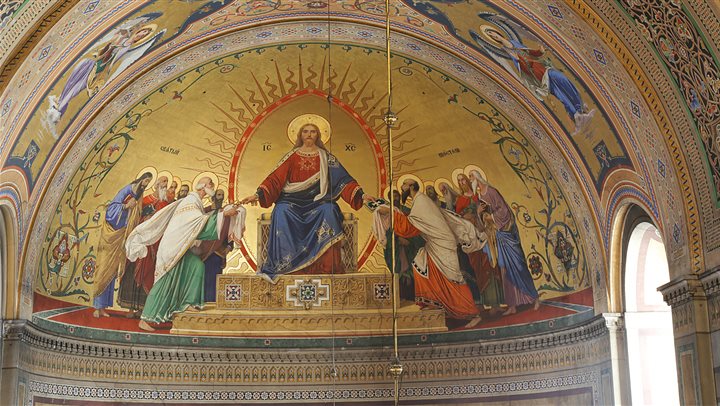St. Spyridon Serbian Orthodox Church
The Church was built between 1861 and 1869, on the basis of a project by Lombard architect Carlo Maciachini, on the site of a previous temple built in 1753 and demolished in 1861 because it had been declared unsafe. It can host 1600 believers.
The building features a Greek-cross plan. It displays the same Byzantine style as Eastern churches and is characterized by a central dome, which is higher than the four bell towers. It also presents semi-spherical grey-blue caps and wide mosaic decorations on the façades drawn by Milanese artists Giuseppe and Pompeo Bertini. The structure is covered in stone from Karst and Istria quarries, as well as Carrara and Verona marbles.
St. Spyridon's image stands out from a golden background above the central door, whereas the images of St. Gregory and St. Athanasius with the Archangel Michael are on the left-hand side, towards the canal; on the right-hand side the Virgin Mary with St. Basil and St. John Chrysostom can be appreciated.
The interior is characterized by fine decorations and oil paintings imitating the mosaic and that were also drawn by Giuseppe Bertini. In the main apse The Christ with Apostles can be admired. The left-hand one presents an illustration of the first Nicaea Ecuminical Council (325 AD) with St. Spyridon; in the right-hand one the Assumption of the Virgin is depicted, together with the Christ Pantocrator on the vault of the dome and Saints and Apostles all around in the tambour.
On its lower side the iconostasis includes four icons of amazing artistic quality and importance, covered in gold and silver. They were made in Russia between 1846 and 1850 and they illustrate St. Spyridon, the Virgin and Child, Christ the King, the Annunciation, which were already present in the first church.
Entering the temple, a silver sanctuary lamp offered by the future Tzar Paul I during his visit to Trieste in 1782, is hung.
The Serbian-Orthodox community settled in Trieste, thanks to the maritime traffics development favoured by Charles VI's proclamation of the Free Port in 1719.
In 1751, Maria Theresa allowed the Greeks and the Illyrians (term used to define the Serbs) to found a religious community and to build a place of worship of their own. In 1781 the two communities parted, in 1793 the Illyrians adopted their own statute and the Greeks built St. Nicholas church along Trieste's seaside promenade.
At the end of the '700s the community counted 200 people - it currently includes around 10,000 - coming almost exclusively from a single place: Požarevac - Passarowitz in German - where, in 1718, the famous treaty between Austria and the Ottoman Empire was signed.
Trieste's Serbian Orthodox church is the most important among the three parishes existing in Italy (the other two are in Vicenza and in Trezzo sull'Adda) and, since May 2011, it is part of the Italian, Austrian and Swiss diocese with the Bishop's seat in Vienna.







